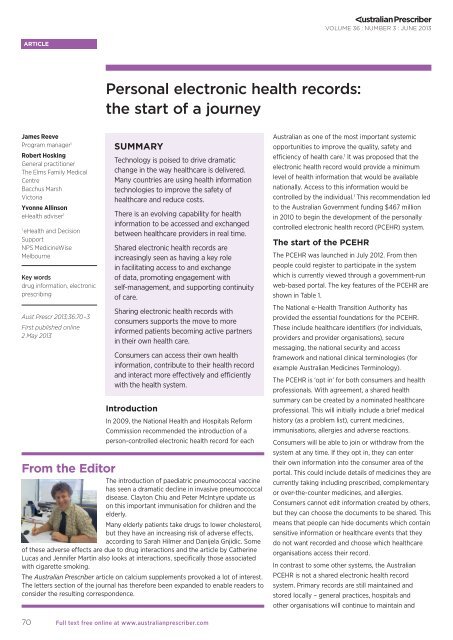download the full PDF issue - Australian Prescriber
download the full PDF issue - Australian Prescriber
download the full PDF issue - Australian Prescriber
You also want an ePaper? Increase the reach of your titles
YUMPU automatically turns print PDFs into web optimized ePapers that Google loves.
VOLUME 36 : NUMBER 3 : JUNE 2013<br />
ARTICLE<br />
Personal electronic health records:<br />
<strong>the</strong> start of a journey<br />
James Reeve<br />
Program manager 1<br />
Robert Hosking<br />
General practitioner<br />
The Elms Family Medical<br />
Centre<br />
Bacchus Marsh<br />
Victoria<br />
Yvonne Allinson<br />
eHealth adviser 1<br />
1<br />
eHealth and Decision<br />
Support<br />
NPS MedicineWise<br />
Melbourne<br />
Key words<br />
drug information, electronic<br />
prescribing<br />
Aust Prescr 2013;36:70–3<br />
First published online<br />
2 May 2013<br />
SUMMARY<br />
Technology is poised to drive dramatic<br />
change in <strong>the</strong> way healthcare is delivered.<br />
Many countries are using health information<br />
technologies to improve <strong>the</strong> safety of<br />
healthcare and reduce costs.<br />
There is an evolving capability for health<br />
information to be accessed and exchanged<br />
between healthcare providers in real time.<br />
Shared electronic health records are<br />
increasingly seen as having a key role<br />
in facilitating access to and exchange<br />
of data, promoting engagement with<br />
self-management, and supporting continuity<br />
of care.<br />
Sharing electronic health records with<br />
consumers supports <strong>the</strong> move to more<br />
informed patients becoming active partners<br />
in <strong>the</strong>ir own health care.<br />
Consumers can access <strong>the</strong>ir own health<br />
information, contribute to <strong>the</strong>ir health record<br />
and interact more effectively and efficiently<br />
with <strong>the</strong> health system.<br />
Introduction<br />
In 2009, <strong>the</strong> National Health and Hospitals Reform<br />
Commission recommended <strong>the</strong> introduction of a<br />
person-controlled electronic health record for each<br />
From <strong>the</strong> Editor<br />
The introduction of paediatric pneumococcal vaccine<br />
has seen a dramatic decline in invasive pneumococcal<br />
disease. Clayton Chiu and Peter McIntyre update us<br />
on this important immunisation for children and <strong>the</strong><br />
elderly.<br />
Many elderly patients take drugs to lower cholesterol,<br />
but <strong>the</strong>y have an increasing risk of adverse effects,<br />
according to Sarah Hilmer and Danijela Gnjidic. Some<br />
of <strong>the</strong>se adverse effects are due to drug interactions and <strong>the</strong> article by Ca<strong>the</strong>rine<br />
Lucas and Jennifer Martin also looks at interactions, specifically those associated<br />
with cigarette smoking.<br />
The <strong>Australian</strong> <strong>Prescriber</strong> article on calcium supplements provoked a lot of interest.<br />
The letters section of <strong>the</strong> journal has <strong>the</strong>refore been expanded to enable readers to<br />
consider <strong>the</strong> resulting correspondence.<br />
<strong>Australian</strong> as one of <strong>the</strong> most important systemic<br />
opportunities to improve <strong>the</strong> quality, safety and<br />
efficiency of health care. 1 It was proposed that <strong>the</strong><br />
electronic health record would provide a minimum<br />
level of health information that would be available<br />
nationally. Access to this information would be<br />
controlled by <strong>the</strong> individual. 1 This recommendation led<br />
to <strong>the</strong> <strong>Australian</strong> Government funding $467 million<br />
in 2010 to begin <strong>the</strong> development of <strong>the</strong> personally<br />
controlled electronic health record (PCEHR) system.<br />
The start of <strong>the</strong> PCEHR<br />
The PCEHR was launched in July 2012. From <strong>the</strong>n<br />
people could register to participate in <strong>the</strong> system<br />
which is currently viewed through a government-run<br />
web-based portal. The key features of <strong>the</strong> PCEHR are<br />
shown in Table 1.<br />
The National e-Health Transition Authority has<br />
provided <strong>the</strong> essential foundations for <strong>the</strong> PCEHR.<br />
These include healthcare identifiers (for individuals,<br />
providers and provider organisations), secure<br />
messaging, <strong>the</strong> national security and access<br />
framework and national clinical terminologies (for<br />
example <strong>Australian</strong> Medicines Terminology).<br />
The PCEHR is ‘opt in’ for both consumers and health<br />
professionals. With agreement, a shared health<br />
summary can be created by a nominated healthcare<br />
professional. This will initially include a brief medical<br />
history (as a problem list), current medicines,<br />
immunisations, allergies and adverse reactions.<br />
Consumers will be able to join or withdraw from <strong>the</strong><br />
system at any time. If <strong>the</strong>y opt in, <strong>the</strong>y can enter<br />
<strong>the</strong>ir own information into <strong>the</strong> consumer area of <strong>the</strong><br />
portal. This could include details of medicines <strong>the</strong>y are<br />
currently taking including prescribed, complementary<br />
or over-<strong>the</strong>-counter medicines, and allergies.<br />
Consumers cannot edit information created by o<strong>the</strong>rs,<br />
but <strong>the</strong>y can choose <strong>the</strong> documents to be shared. This<br />
means that people can hide documents which contain<br />
sensitive information or healthcare events that <strong>the</strong>y<br />
do not want recorded and choose which healthcare<br />
organisations access <strong>the</strong>ir record.<br />
In contrast to some o<strong>the</strong>r systems, <strong>the</strong> <strong>Australian</strong><br />
PCEHR is not a shared electronic health record<br />
system. Primary records are still maintained and<br />
stored locally – general practices, hospitals and<br />
o<strong>the</strong>r organisations will continue to maintain and<br />
70<br />
Full text free online at www.australianprescriber.com
















